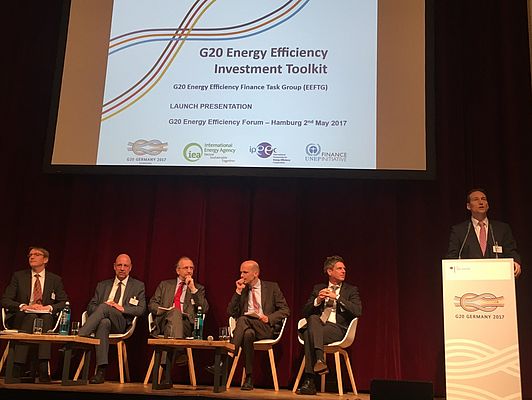On 2nd May I was fortunate enough to present at the G20 Energy Efficiency Forum and take part in a panel discussion. The G20 energy efficiency work has not got much attention but there are some good things happening and at the event the group, with 15 participating countries chaired by France and Mexico, launched its G20 Energy Efficiency Toolkit. The toolkit offers a perspective on scaling up energy efficiency investments by defining and separating:
- “Core” EE investments – those stand-alone projects where energy savings are the main driver and
- “Integral” investments where overall asset performance is the lead driver but energy efficiency is delivered as one of multiple benefits over and above the main driver.
The global investment in energy efficiency has been identified by the IEA as $221bn with the US, EU and China representing 70% of the total. Within the EU 80% of the total investments were in buildings, with over 90% in Germany, UK and France. The toolkit reports that the largest “core” energy efficiency investment is in the market for Energy Performance Contracts which totaled $24 billion. I assume this means third party investment as internal balance sheet financed projects are surely much higher.
G20 EE Toolkit
The G20 EE Toolkit offers advice to different groups including policy makers, private sector banks, institutional investors and the insurance sector. It also gives case studies from various countries including Mexico, France, China, Australia and others.
There are parallels with my energy productivity work for KAPSARC. In that I distinguished between “energy efficiency” investments and “normal investments”, a definition which parallels the G20’s “core” and “integral”. Energy efficiency investments are those where the main purpose is energy saving. This includes much of what we usually think of as energy efficiency, retrofitting buildings or production lines for example. While these are important at any one time hundreds of investment decisions are being taken on all kinds of infrastructure that will affect our energy consumption and emissions for the next twenty to fifty years or even beyond. Most of these are not “energy efficiency investments” but “normal” investments where the main purpose is not energy efficiency.
Financing Energy Efficiency
Pure energy efficiency investments can be ramped up by specialized funds or facilities and public-private partnerships with public finance providing development capital and guarantees. Any program needs to:
- Provide finance
- Build pipelines of projects
- Build capacity in end-users, energy efficiency industry and finance industry
- Standardize development process, documentation, contracts and measurement
Encouraging the growth of the ESCO-EPC market also helps drive pure energy efficiency investments. This can be done through models like ESCO-EPC facilitation (e.g. Berlin, RE:FIT) and Super-ESCOs (e.g. Etihad).
It is also important to build market infrastructure through:
- Standardization of process (e.g. Investor Confidence Project)
- Standardization of contracts (e.g. standard EPCs)
- Standardization of Measurement & Verification
- Build evidence bases of project performance
- Build capacity within financial sector.
It is also important to continue to build demand through strong Minimum Energy Performance Standards and building capacity in energy management through standards e.g. ISO 50001
Missed Opportunities?
As well as ramping up pure energy efficiency or core investments we need to ensure the efficiency opportunities presented by normal investments are not being missed. Even if you design a building to code and that makes it low energy compared to existing buildings it is not really doing anything to improve the situation – I would not count it as an energy efficiency investment. It is a normal investment and a missed opportunity to include cost-effective energy efficiency measures.
Every day, in design and investment decisions around the world, the economic potential to improve energy efficiency beyond business as usual is being missed. We need to change that through better regulation, capacity building amongst investors, specifiers and designers and implementing better design processes such as integrated design. Banks and investors can help this process by building in checks and questions during their investment decision making.
These processes should force borrowers to review their specifications and designs. EBRD has been doing this for a long time. By doing this the banks can reduce customer risks by reducing their energy bills and increase the deployment of capital into cost-effective opportunities.
To scale up energy efficiency we need to take actions to increase the rate energy efficiency investments, and actions to increase the uptake of cost-effective efficiency opportunities within normal investments.
By Steven Fawkes, Founder and Managing Partner at EnergyPro Ltd























































